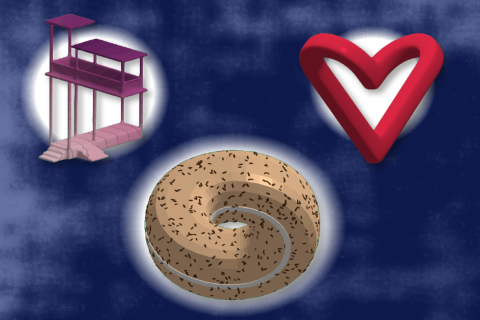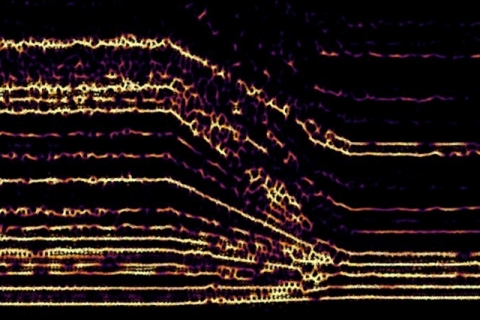Research Group
Geometric Data Processing Group

Geometry is a central component of algorithms for computer-aided design, medical imaging, 3D animation, and robotics. While early work in computational geometry provided basic methods to store and process shapes, modern geometry research builds on these foundations by assembling unstructured, noisy, and even probabilistic signals about shape into robust models capturing semantic, geometric, and topological features. Geometric techniques in two and three dimensions also can prove valuable in high dimensions: Distances and flows make sense when analyzing abstract data, from corpora of text to clicks on a website, suggesting that geometric inference applies far beyond shapes gathered from robotic sensors or virtual reality environments. Research in this domain demands theoretical grounding from modern differential geometry and topology while coping with the realities of uncertainty and incompleteness that appear in computation and statistics.
Merging these appearances of geometry in computation suggests the broad application of geometric data processing, in two senses:
- [Geometric data] [processing]: Algorithms for processing geometric data, and
- [Geometric] [data processing]: Data processing using geometric techniques.
Our team's research aims to widen the scope of "geometric data processing" to encapsulate the theory, algorithms, and applications for shape processing applied to abstract datasets and 3D surfaces alike.
Optimal transport
A central theme in our research involves algorithms and applications for optimal transport (OT). OT lifts classical geometry to probability distributions, providing a means for geometric computation on uncertain data. The key computational challenge in bringing OT to applications, however, is to develop efficient algorithms for solving a large-scale, geometrically-structured linear program to evaluate OT distances. Our group has advanced the forefront of applied OT by expanding its scope and scalability, transitioning OT from theory to practice. Our numerical OT algorithms leverage the structure of the domain to accelerate the most critical and common applications, including approximate OT on meshes and grids for graphics, stochastic techniques for learning, graph algorithms for operations, and finite elements for scientific computing. This new machinery enables countless applications for OT, from surface correspondence, audio effects, and vector field design in graphics/media to Bayesian inference, document retrieval, label propagation, and representation learning in machine learning.
Shape analysis
A classical thread of our research in graphics and scientific computing involves fine-grained 3D shape analysis, adapting elegant theory from modern geometry to the algorithmic domain. Several recent projects involve volumetric (intrinsically three-dimensional) geometry, tackling subtle issues that arise when lifting algorithms for 2D domains like surfaces to 3D volumes. These challenges are both theoretical and algorithmic: Three-manifold topology is far more complex than the two-dimensional case of surfaces, and well-known shape analysis algorithms exponentiate in the dimensionality of the data. Our recent papers demonstrate how to lift spectral shape retrieval to volumes without loss in algorithmic efficiency, and we have advanced the algebraic and topological theory needed for volumetric vector/frame field design and meshing. We also have proposed representations and algorithms for surface correspondence, including functional maps, soft maps, and conventional mapping with nonlinear elasticity.
Learning from geometric data
Our team has proposed sensible units for learning from geometric data based in theory, just as convolution was a part of image processing before appearing in neural networks. To this end, we have introduced architectures for several species of data, including point clouds, parametric shapes, and meshes. Our algorithms for learning from geometry are widely adopted, with unexpected applications; for example, our dynamic graph CNN (DGCNN) model yields top results for inference problems in high energy physics.
Applications
Our team welcomes collaborators from other disciplines, leading to fruitful projects digging into the details of applied geometric data processing. For example, we have launched a collaboration between computer scientists, mathematicians, and civil rights organizations developing technical tools for redistricting, leading to outreach efforts, open source software titled "GerryChain" for sampling in the space of districting plans, and research on computational aspects of redistricting. With colleagues in CSAIL and in local hospitals, we are applying geometry processing to BOLD MRI placenta imaging to support pregnancy assessment and improve care. Other recent collaborations have led to tools for vectorization of hand-drawn sketches and for exploring trade-offs in manufacturing design.
Future directions
Many projects above have launched long-term investigations in geometry, computation, and applications. For example, OT operates on distributions but largely has not been connected to statistical theory, so we are examining statistical aspects of transport and derived problems with application in distributionally-robust learning and noisy communication. In shape analysis, we continue to develop the fundamental topological and differential-geometric machinery needed to transfer the success of surface-based methods to volumes, drawing inspiration from differential topology and the physics of topological defects. Our efforts in learning from geometry focus on fusing multiple modalities (e.g., images and point clouds) to improve performance for applications like autonomous driving, and our interdisciplinary collaborations have expanded to include partners in physics, computer-aided engineering (CAE), and network analysis.
Related Links
Contact us
If you would like to contact us about our work, please refer to our members below and reach out to one of the group leads directly.
Last updated Jan 25 '20
















